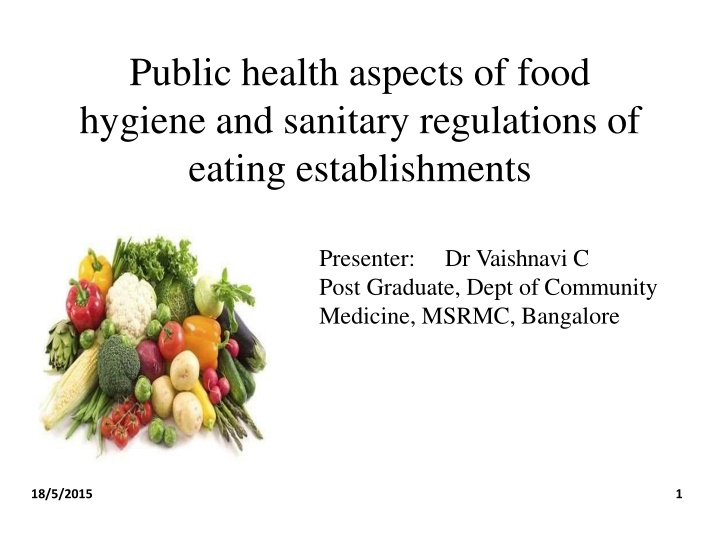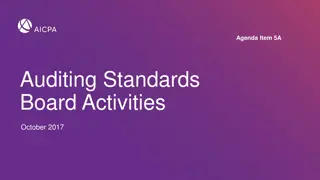
Public Health Aspects of Food Hygiene and Sanitary Regulations in Eating Establishments
Explore the major public health issues related to food safety, the role of health workers in ensuring food safety, and the laws and regulations governing food safety in India. Learn about the standards for eating establishments, food handlers, safety in anganwadis and street foods, hazard analysis, critical control points, food surveillance, and monitoring systems. Understand the importance of food safety to prevent food poisoning and other illnesses caused by contaminated food.
Download Presentation

Please find below an Image/Link to download the presentation.
The content on the website is provided AS IS for your information and personal use only. It may not be sold, licensed, or shared on other websites without obtaining consent from the author. If you encounter any issues during the download, it is possible that the publisher has removed the file from their server.
You are allowed to download the files provided on this website for personal or commercial use, subject to the condition that they are used lawfully. All files are the property of their respective owners.
The content on the website is provided AS IS for your information and personal use only. It may not be sold, licensed, or shared on other websites without obtaining consent from the author.
E N D
Presentation Transcript
Public health aspects of food hygiene and sanitary regulations of eating establishments Presenter: Post Graduate, Dept of Community Medicine, MSRMC, Bangalore Dr Vaishnavi C 18/5/2015 1
Contents Introduction Major Public Health issues of food safety Five keys to safer food Role of health workers in food safety Laws and Regulations governing Food safety in India Standards for eating establishments Food handlers 18/5/2015 2
Contents contd... Food safety in anganwadis Street food safety Hazard analysis and critical control points(HACCP) Food surveillance and monitoring system in India Conclusion References 18/5/2015 3
Introduction Food Safety and Standards Act2006, any substance, whether processed, partially processed or unprocessed, which is intended for human consumption. does not include any animal feed, live animals unless they are prepared or processed for placing on the market for human consumption, plants prior to harvesting, drugs and medicinal products, cosmetics, narcotic or psychotropic substances. 18/5/2015 4
Introduction contd... Important to sustain life Can also result in ill health Also may result from what a food contains rather it lacks Potential source of infection 18/5/2015 5
Food Safety WHO, all conditions and measures that are necessary during the production, processing, storage, distribution and preparation to ensure that it is safe, sound and wholesome and fit for human consumption . Primary aim is to prevent food poisoning and other food borne illnesses 18/5/2015 6
Illness due to contaminated food is perhaps the most widespread health problem in the contemporary world and an important cause of reduced economic productivity. -FAO & WHO, 1983 18/5/2015 7
Major public health issues in foodhygiene 1/3rd of the population in developed in countriesaffected 2.2 million death annually in developingcountries >10% of the world s population at risk Significantly affect people s health and well-being Impose a substantial burden on health-care systems & markedly reduce economic productivity. 18/5/2015 8
Causes of food borne illness: 9 18/5/2015
Microbiological hazards -Three key factors generallycontribute- contamination growth survival 18/5/2015 1 0
Microbiological hazards Bacterial infections- E. coli (25%), C. Jejuni (10-15%), Shigella (5-15%) Parasitic infections - Giardia lamblia, Entamoeba histolytica, Toxoplasma gondii, Sarcocystis hominis, Fasciola hepatica, Taenia solium and T.saginata Viral Infections Polio, Hepatitis-A,E, Norwalk-like agents, Enterovirus and Rotavirus. 18/5/2015 11
Chemical hazards Natural toxicants or anti nutritionalfactors Oxalic acid (rhubarb, spinach), solanine & glycol alkaloids (potatoes), dioscorine (yams), haemagglutinin (red kidney beans) protease inhibitors (legumes), amatoxin, psilocybin and others(toxic mushroom), environmental contaminants 51% of food commodities are contaminated with pesticide residues in India. 18/5/2015 12
Physical hazards Extraneous material or foreign objects that are not normally found in foods Care and vigilance are the best ways to avoid physicalhazards. 18/5/2015 13
Milk Hygiene 18/5/2015 14
Milk Hygiene Methods of Pasteurization: Holder (Vat) method Continuous Flow Method High Temperature Short Time (HTST) Method Ultra high temperature (UHT) Method Pasteurization in Bottles 18/5/2015 15
Milk Hygiene Laboratory Tests: Specific Gravity Chemical Tests (i) Gerber sTest (ii) TotalSolids (iii) Methylene BlueTest (iv) PhosphataseTest (v) BacteriologicalTests Inspection of Dairies and Milk Depots 16 18/5/2015
Meat and fish hygiene Inspection: Smell Appearance and Firmness Colour Skewer Thrust Test(Meat) Eyes & Floatation Test(Fish) 17 18/5/2015
Tinned Meat Tins / Cans to be Viewed with Suspicion Damaged, dented or rusted tins Leaking tins Excessively convex tins Blown tin (owing to the formation of gas from decomposition) A bulging tin underpressure Tainted, foul smelling or bad taste of contents If in doubt, subject to laboratoryanalysis 18 18/5/2015
Slaughter HouseSanitation Structural soundness of the building Fly proofing, rat proofing and dog proofing of the premises. Method of disposal of offal, blood, discarded animal tissues Sanitation of the lair Separate slaughtering, skinning and hanging rooms Availability of water for maintaining the sanitation Maintenance of equipment of slaughtering, skinning & handling finally the personal hygiene of the workers 19 18/5/2015
Five keys for saferfood 1) Keep clean 2) Separate raw and cooked food 3) Cook thoroughly 4) Keep food at safe temperatures 5) Use safe water and raw materials 18/5/2015 20
The role of health workers in food safety Education in food safety Focused and relevant to the targetaudience Specific target groups for food safety education HACCP-based approach Surveillance of food borne diseases 18/5/2015 21
Food Standards and SafetyAct,2006 18/5/2015 22
Emphasis of the law Safe and wholesome food for human consumption Laying down Food Safety standards on scientific basis Unified law All issues are addressed comprehensively Creation of infrastructure for testing and certificationprocedures promote recognition, co-ordination with governmental and nongovernmental organisation world over. 18/5/2015 23
Bureau of Indian Standards (BIS): Cover raw materials and their quality parameters, hygienic conditions under which products are manufactured and packaging and labelling requirements. Obtain the ISI Mark that can be exhibited on productpackages 18/5/2015 24
Directorate of Marketing and Inspection (DMI) / AGMARKStandards Ministry of Agriculture enforces the Agricultural Products (Grading and Marketing) Act1937 AGMARK - grading of an article in accordance with grade/standards Use "AGMARK" labels on their products if they comply with standards 18/5/2015 25
National Codex Committee (India) To advise government on the implications of various food standardization To provide important inputs to the government so as to assist in ensuring quality and safety of food To appoint Shadow Committees To meet as and when necessary to formulate national position. 18/5/2015 26
Standards for eatingestablishments FSSAI , Premises where public is admitted for repose or for consumption of any food or drink or any place where cooked food is sold or prepared for sale Excludes: Food processing establishments, retail food stores, private homes where food is prepared or served for family consumption. 18/5/2015 27
Eating establishments Restaurants & Hotels Dhaba Snack Bars Canteens (Schools, Colleges, Office, Institutions) Food Service at religious places Neighbourhood Tiffin Services / dabba walas Street food vendors 18/5/2015 28
Eating establishments Specific characteristics that make them potential focus of food borne outbreaks or epidemics: Single infection may affect many people simultaneously Much of the food is prepared in advance of the normal mealtime rush Hours tend to encourage poor and unsatisfactory methods of dish-washing 18/5/2015 29
Eating establishments Improper holding temperatures Inadequate cooking, such as undercooking raw shelleggs Contaminated equipment Food from unsafe sources, and Poor personal hygiene 18/5/2015 30
Standards of eating establishments Location and surroundings: away from environmentally polluted areas and industrial activities not be used for residential purpose Layout and design of food establishment premises: food preparation / manufacturing process are not subject to cross-contamination from receiving & pre processing Area occupied by machinery shall not be more than 50% of the manufacturing area. 18/5/2015 31
Standards of eating establishments Kitchen premises- General principles: Spacious, lighted, fly proof, rat proof, airy and spotlesslyclean Floors: must have non slip surfaces should be impervious Ceiling: should be smooth, resist condensation with provisions for exhaust/chimney vents Lighting: must be good both natural and artificial Ventilation: both natural and artificial is necessary Toilets: Foot operated flushes are more preferable 18/5/2015 32
Standards of eating establishments Kitchen proper Kitchen equipment Preparation room Store room Scullery Dining Room 18/5/2015 33
Washing arrangements Good layout of washing-up area Correct temperature of wash and rinse water A good detergent suited to the type ofwater Orderly methods of work in rinsing, stacking, racking,and storage 18/5/2015 34
Standards of eating establishments WashingArrangements One Sink Method Two Sink Method Dish washing machine 18/5/2015 35
Standards of eating establishments Waste disposal: Within the kitchen - pedal-operatedbins Outside the kitchen Environmental control: Control of Flies Cockroaches Sprays and other insecticide formulations 18/5/2015 36
Food Handlers Immaculate personal hygiene of the cooks - prime importance in the prevention of food borne infections Cooks must be subjected to regular medical examinations for communicable diseases Worthwhile doing a stool examination They should also be vaccinated against the enteric group of fevers. 18/5/2015 37
Disease Work status Duration Restriction / comments of Work Abscess, boils, etc Relieve from direct contact Until drainage stops and lesion has healed or and food handling. employee has negative culture. AIDS or ARC(AIDS May work (per CDC Employee will be guidelines). related counselled No open lesions, upper complex) andeducated. respiratory diseases, or 18/5/2015 38 communicable diseases.
directUntil symptoms resolve and infection Salmonella, Shigella or Campylobacter is ruled out Acute stage (aetiology Relieve from with known) food handling. Campylobacter Relieve food handling. from direct Until symptoms resolve or after antibiotic therapy for 48 hours direct Until stool is free of the infecting organism in two cultures, not less than 24 hours apart appropriate Salmonella Relieve food handling. from consecutive
Shigella Relieve food handling. from direct Until stool is free of the infecting organism in two cultures, not less than 24 hours apart consecutive HepatitisA Relieve food handling. from direct Until seven days after onset of jaundice. Must bring physician upon return note from Staphylococcus aureus Relieve food handling. from direct Until lesions have resolved employee has negative culture and the
Personal cleanliness Any cut or wounds - not come in direct contact Wash their hands with soap and clean potable water Refrain themselves from smoking; spitting; chewing or eating; sneezing or coughing over any food Trim their nails periodically 18/5/2015 41
Food hygiene in anganwadis Pregnant mothers, infant and young children are especially vulnerable to infection Local procurement - FIFO (First in First Out) Storage of raw materials Safety Measures during Cooking Precaution taken before serving Safety Measures while Feeding 18/5/2015 42
Street food safety in India Challenges to street food safety: Lack of basic infrastructure and services Difficulty in controlling the large numbers of street food vending operations Insufficient resources for inspection and laboratoryanalysis. General lack of factual knowledge Poor knowledge in basic food safety measures. Inadequate public awareness of hazards 18/5/2015 43
Street food safety in India Policies and provision on street foods: National Policy on Urban Street Vendors - Ministryof Housing and Urban Poverty Alleviation in2009 Street Food Vendors- Food Safety Requirements - BIS More recently, 2012- schedule 4 of the FSSAI 18/5/2015 44
Hazard Analysis and CriticalControl Points(HACCP) Approach to food safety focusing on identifying and controlling critical points Food handlers are trained to implement key strategies to eliminate infection triggers at criticalpoints Specified by the Codex Alimentarius,1997 18/5/2015 45
HACCP Seven basic principles: Analyze hazards Identify critical control points Establish preventive measures Establish procedures to monitor the critical controlpoints Establish corrective actions Establish procedures to verify the system Establish effective record keeping 46 18/5/2015
Food surveillance and monitoring system in India To ensure that the food supplied in the market is safe Allow the identification of potential area of focus to be tabled for subsequent action by the food authority Organize the collection, retrieval and analysis of information Plan and implement five yearly dietary surveys Establish a data bank Ensure that good agricultural, manufacturing and laboratory practices are followed 47 18/5/2015
Conclusion Food - not only an agricultural or trade commodity, but also a public health issue Food safety - an essential public healthfunction Must be integrated with the three sectors government, industry and consumers Necessary that food safety forms an essential component of health-based nutrition policies and nutritioneducation. 18/5/2015 48
References 1. Balwar R, Vaidya R, Tilak R, Guptha RK, Kunte R. Textbook of Public Health and Community Medicine. 1sted. Department of community medicine, AFMC, Pune in collaboration with WHO India office.New Delhi (India); 2009. p.772-91 2. Park K. Park s Textbook of preventive and social medicine. 22 ed. Jabalpur (India): BanarasidasBhanot Publishers; 2013. P.654-6 3. Operational guidelines for food safety and hygiene for supplementary nutrition under ICDS. Ministry Of Health and Family Welfare. Govt. Of India [Online] 2013 Dec 24 [cited on 2015 Apr 23]; Avialable from:URL: http://wcd.nic.in/order20122013/merged_document_3.pdf
References 4. Jacob M. Safe food handling a training guide for managers of food establishments. World Health Organisation [online] 1989 [cited on 2015 Apr 23]; Avialable from:URL: http://apps.who.int/iris/handle/10665/36870 5. Kaferstein FK. Food safety in food security and food trade. International food policy research institute [online] 2003 Sep [cited on 2015 May 2]; Avialable from:URL: http://www.ifpri.org/sites/default/files/publications/focus10.pdf / Final.pdf







